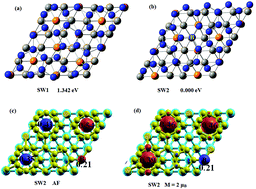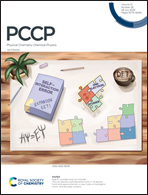Structural and magnetic properties of a defective graphene buffer layer grown on SiC(0001): a DFT study
Abstract
Understanding the role of defects in the magnetic properties of the graphene buffer layer (BL) grown on substrates should be important to provide hints for manufacturing future graphene-based spintronic devices in a controlled fashion. Herein, density functional theory was applied to assess the structure and magnetic properties of defective BL on 6H-SiC(0001). Particularly, we conducted a thorough study of one and two vacancies and Stone–Wales defects in the BL. Our results reveal that the removal of a carbon atom in the BL framework that was originally bonded to a Si atom in the substrate is preferred over that of a sp2-bonded atom. As a result, a hexacoordinated silicon atom is formed with a slightly deviated octahedral geometry. A stable antiferromagnetic (AF) state was verified for the single vacancy system, with a quite different spin-density distribution to the one obtained for the perfect BL. Also, this AF state is nearly degenerate with the non-magnetic and low magnetic states. As for the Stone–Wales defect, the AF sate is almost degenerate with the most stable M = 2 μB magnetic configuration. However, the introduction of two vacancies in the carbon network of BL causes the loss of magnetism of the BL–SiC system. Our theoretical calculations support experimental predictions favoring the BL as the site for single vacancy formation rather than the epitaxial monolayer graphene, by 4.3 eV.



 Please wait while we load your content...
Please wait while we load your content...